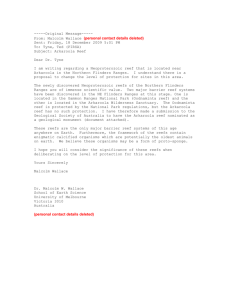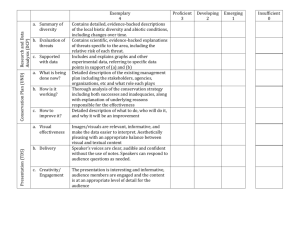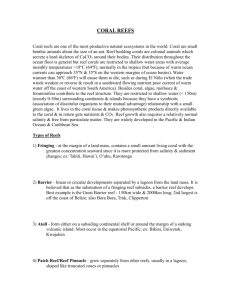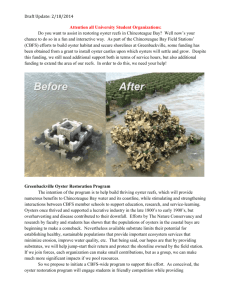Late Holocene History of Oyster Reef Development in Estero Bay
advertisement
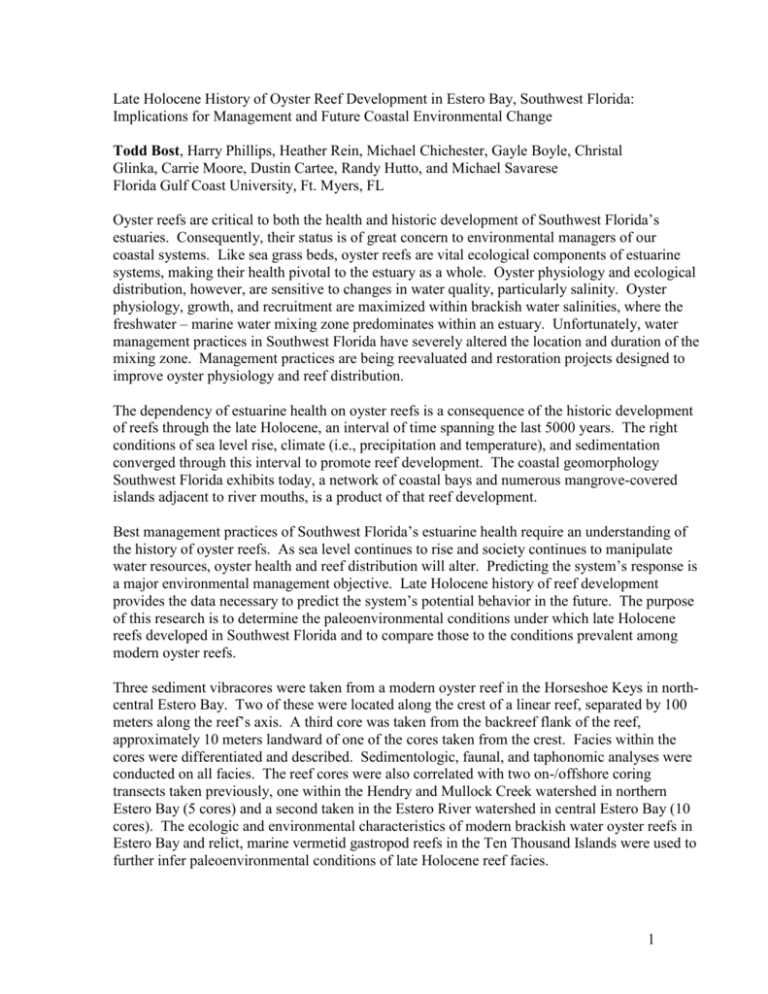
Late Holocene History of Oyster Reef Development in Estero Bay, Southwest Florida: Implications for Management and Future Coastal Environmental Change Todd Bost, Harry Phillips, Heather Rein, Michael Chichester, Gayle Boyle, Christal Glinka, Carrie Moore, Dustin Cartee, Randy Hutto, and Michael Savarese Florida Gulf Coast University, Ft. Myers, FL Oyster reefs are critical to both the health and historic development of Southwest Florida’s estuaries. Consequently, their status is of great concern to environmental managers of our coastal systems. Like sea grass beds, oyster reefs are vital ecological components of estuarine systems, making their health pivotal to the estuary as a whole. Oyster physiology and ecological distribution, however, are sensitive to changes in water quality, particularly salinity. Oyster physiology, growth, and recruitment are maximized within brackish water salinities, where the freshwater – marine water mixing zone predominates within an estuary. Unfortunately, water management practices in Southwest Florida have severely altered the location and duration of the mixing zone. Management practices are being reevaluated and restoration projects designed to improve oyster physiology and reef distribution. The dependency of estuarine health on oyster reefs is a consequence of the historic development of reefs through the late Holocene, an interval of time spanning the last 5000 years. The right conditions of sea level rise, climate (i.e., precipitation and temperature), and sedimentation converged through this interval to promote reef development. The coastal geomorphology Southwest Florida exhibits today, a network of coastal bays and numerous mangrove-covered islands adjacent to river mouths, is a product of that reef development. Best management practices of Southwest Florida’s estuarine health require an understanding of the history of oyster reefs. As sea level continues to rise and society continues to manipulate water resources, oyster health and reef distribution will alter. Predicting the system’s response is a major environmental management objective. Late Holocene history of reef development provides the data necessary to predict the system’s potential behavior in the future. The purpose of this research is to determine the paleoenvironmental conditions under which late Holocene reefs developed in Southwest Florida and to compare those to the conditions prevalent among modern oyster reefs. Three sediment vibracores were taken from a modern oyster reef in the Horseshoe Keys in northcentral Estero Bay. Two of these were located along the crest of a linear reef, separated by 100 meters along the reef’s axis. A third core was taken from the backreef flank of the reef, approximately 10 meters landward of one of the cores taken from the crest. Facies within the cores were differentiated and described. Sedimentologic, faunal, and taphonomic analyses were conducted on all facies. The reef cores were also correlated with two on-/offshore coring transects taken previously, one within the Hendry and Mullock Creek watershed in northern Estero Bay (5 cores) and a second taken in the Estero River watershed in central Estero Bay (10 cores). The ecologic and environmental characteristics of modern brackish water oyster reefs in Estero Bay and relict, marine vermetid gastropod reefs in the Ten Thousand Islands were used to further infer paleoenvironmental conditions of late Holocene reef facies. 1 Horseshoe Keys’ reef cores show similar facies transitions in response to late Holocene transgression. Early Holocene or Pleistocene (age indeterminate) supratidal sands are overlain by intertidal mangrove peats. The peats demark the onset of marine flooding and date at approximately 4300 ybp within central Estero Bay. These sediments are followed in most cores by a shallow subtidal estuarine facies, dominated by euryhaline molluscs. Reef boundstones develop as the marine transgression culminates. Vermetiform gastropods, belonging to the families turritellidae and vermetidae, dominate early in the history of reef development. Regression then follows with oyster boundstones gradually replacing vermetiform boundstones as more estuarine conditions return in response to coastal progradation. Vermetiform boundstones, located at the base of the reef sequence, are inferred to have a more normal marine origin. The fauna associated with the vermetiform gastropods is more stenohaline in character; the taphonomic features of the shells (e.g., abundance of biocorroders and encrusters; poor taphonomic grades) are more consistent with a normal marine environment; and sedimentary textures are indicative of higher energy, wave-dominated settings. Additionally, modern vermetids and turritellids are found in environments less influenced by freshwater. A preliminary radiocarbon date from vermetiform gastropods from the middle of the reef boundstone facies approximates 3100 years before present, suggesting that reef initiation occurred just prior to this time. The abundance of vermetiform gastropods decreases while shells from the eastern oyster, Crassostrea virginica, become more abundant upsection within the reef sequence, further suggesting that conditions became more estuarine through time. Maximal oyster productivity and reef development today occur in brackish, more protected estuarine settings. The concomitant occurrence of other estuarine taxa, the improvement in shell taphonomic grade, the loss of many shell biocorroding and encrusting species, and the finer-grained, more poorly sorted sediments all support an inferred paleoenvironmental shift to greater freshwater influence. The precise timing of this environmental shift during the late Holocene is presently unknown. Parkinson (1989), working within the Ten Thousand Islands, hypothesized that vermetiform gastropod reefs form the underpinning of mangrove-forested, coastal outer islands (longshore drift-formed barrier islands are absent from the Ten Thousand Islands). Our results are consistent with these observations. If true throughout the Southwest Florida coast (preliminary supportive data now exist for the Ten Thousand Islands, Henderson Creek, Estero Bay, and the Caloosahatchee River), we pose that the formation of coastal vermetiform reefs was responsible for enclosing and protecting the coast, thereby creating the estuarine bay environments best suited for subsequent oyster reef development. Development of vermetiform reefs would have triggered an autogenic succession that grossly influenced coastal geomorphology and evolution. Latest Holocene oyster-dominated reef formation is dependent upon a slow sea level rise rate (< 10 cm / 100 y). Oyster reefs experience high rates of sedimentation, rates that match or exceed sea level rise. This permits the persistence of protected estuaries and leads to the progradation of the coast. The relative timing of reef successional change seen in our cores is consistent with a reported deceleration in sea level rise approximately 3200 ybp. If the accelerated sea level rise rate which began at the onset of the industrial revolution (increase by an order of magnitude when compared to the prior 3000 years) is maintained in the immediate future, oyster reef 2 development will eventually cease and the current Southwest Florida geomorphology will quickly degrade. Because Southwest Florida’s estuarine ecology is so dependent upon the oyster reef ecosystem, the character of our future estuaries may be radically different from what we currently experience. The implications this has for future environmental management and restoration are outstanding. This research was conducted as a collaborative student project within M. Savarese’s upper division undergraduate course in Geobiology during the fall, 2002 semester. Michael Savarese, Florida Gulf Coast University, Marine Science Program, 10501 FGCU Blvd South, Ft. Myers, FL 39965, Phone: 239-590-7165, Fax: 239-590-7200, msavares@fgcu.edu 3
